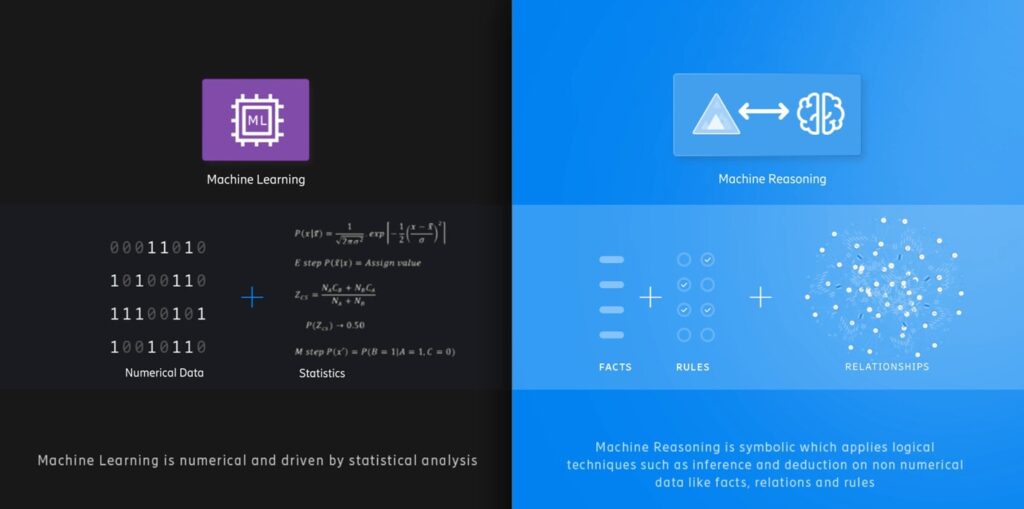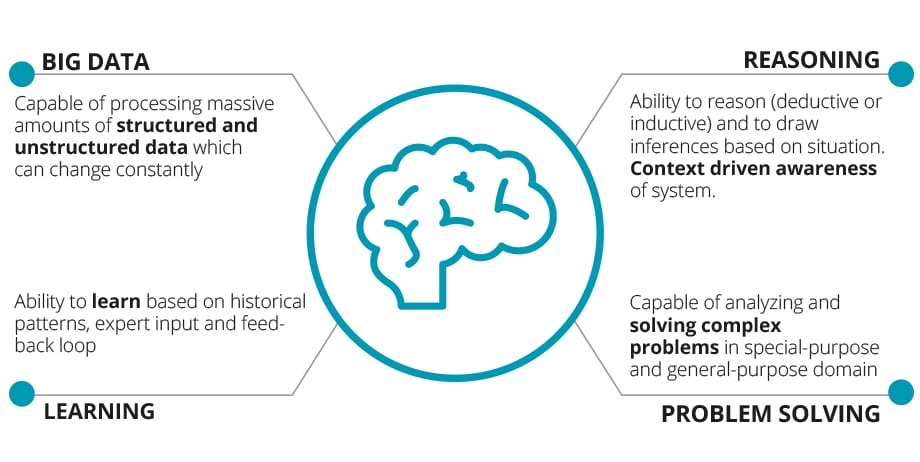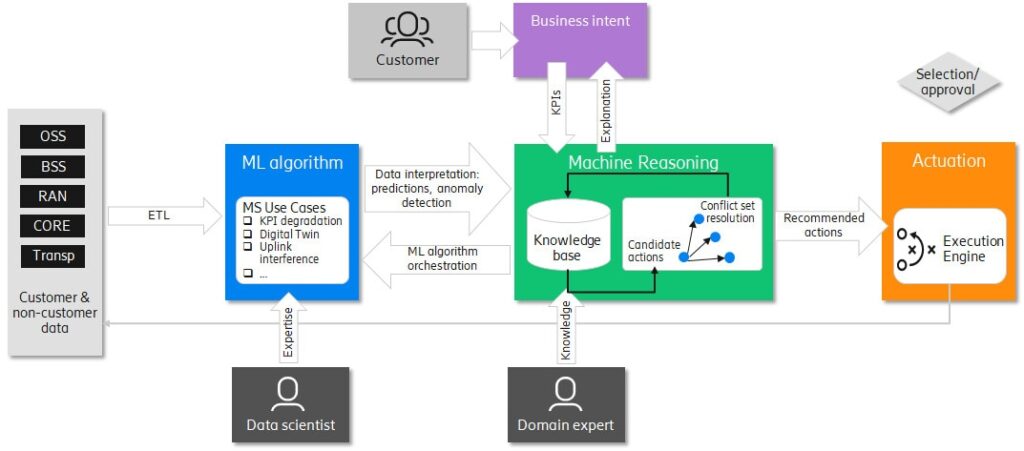
Recent years have witnessed a rapid growth and adoption of machine learning (ML) in many areas, from vision and language processing platforms, to information retrieval and recommendation systems in social networks, or conversational agents to interact with customers.
Various approaches have demonstrated effectiveness in associative learning by extracting similarity patterns from data, but the area still requires a large amount of research in the coming years to advance towards cognitive intelligence.
This article aims to provide a definition of machine learning (ML) and its shortcomings, while introducing the machine reasoning (MR) concept and explain its benefits witch focus on telco network automation and operations.
The Evolution of Machine Learning in Recent Years

From its earliest days, AI researchers have recognized that the ability to learn is an important aspect of human intelligence. The question is how do people learn? And can we program computers to learn the same way?
Learning presumably comes mainly from experience, practice, or training, not solely from reasoning. A child learns from his parents, teachers, friend, he learns throughout the years from his own experience. To say that something is learned implies that it is more than just captured and stored, it must be represented in some way that it can be put in use.
Similarly, computer programs that learn extract patterns from data. That data takes a seemingly infinite variety of forms; video taken from a movie car, reports of emergency, room visits, surface temperatures in the Arctic, Facebook likes and trails, recording of human speech, clicks on online ads, birth records, phone calls, tweets, etc. Just about anything that can be captured, quantified, or represented in digital form can be turned into learning data.
People have been collecting and analyzing data for a long time. What is new and different is the vast scale and some of the novel computational techniques that seem to mimic certain aspects of the human brains. The new data-centric approach to AI goes by several names, most commonly machine learning. The design philosophy of the most advanced architectures in machine learning called neural network architectures or deep learning, imitates how our brain neurons work and is based on learning statistical and associative similarity patterns from large scale training data.
The goal of machine learning algorithms is to find specific patterns in large data sets. Once an algorithm has successfully identified a reasonable pattern, further procedures can be used to create a new subset of data and identify new patterns. Thus, the entire system is optimizing the existing knowledge or “learning”. In general, four types of learning are distinguished: 1) Supervised learning , 2)Unsupervised learning , 3) Reinforcement learning , 4) Semi-supervised learning.
The most common used algorithms right now are: Regression algorithms , Decision tree algorithms , Clustering algorithms , Artificial neural network algorithms , Deep learning, Instance-based algorithms, Dimensionality reduction.
Machine learning systems have become the most impactful subset of artificial intelligence systems applied across important commercial applications. They have excelled in a wide variety of complex tasks, such as speech recognition, computer vision, robotics, and natural language processing. These tasks are stimulus-based. A stimulus comes in, is processed, and an output is produced. They are also tasks that are intuitive or instinctive to humans. In the early decades of AI, the processing of these kinds of tasks was the principal focus.
Machine Learning Brings Value, but Has Some Shortcomings
Machine learning can process large volumes of data and capture the hidden patterns needed to effectively predict outcomes. They tackle a pre-determined problem, with clear inputs and expected outputs. For many early applications and use-cases, this worked well as the questions and needed data were generally available. This type of problem solving achieved through AI is often referred to as Narrow AI because it is really only solving very specific, hence narrow, problems.
Now we are continuously faced with situations where there is simply not enough data, or it is difficult and/or costly to acquire the needed datasets to make machine learning work. Machine learning underperforms when data is lacking, few initial conditions are available, there are too many constraints and there is only one shot to get it right.
Machine learning is less suited to tasks that require more careful, deliberate, and explicit thinking. Examples include the reading of comprehension tasks where you actually have to understand the interactions and relations between characters and events, common sense reasoning and problem solving, making explicit plans for a series of actions, or playing the strategic board games that many of us enjoy in our spare time.
It is less effective when exposed to data that falls outside the distribution that the algorithms were trained on. It is a form of AI that learns from experience. When facing a familiar situation, it is able to predict the outcome. But when faced with a new scenario it becomes confused. It has a poor ability to generalize, an inability to re-use or transfer previously acquired experience, address problems that are slightly different from the original, or when encounter novel inputs.
Machine learning is rarely able to explain how they came up with the solution or explain the reasoning. This neither promotes human trust of the recommendations produced nor decision quality. So, this is where machine reasoning comes in. The question is, what does it mean?
Taking the Next Step of the Artificial Intelligence: Machine Reasoning

The evolution of Artificial Intelligence, from this Narrow AI with limited capabilities, toward a more generalized artificial intelligence that replicates the way humans respond in various situations, requires something different.
For humans, learning is the physical process of acquiring knowledge that allows us to structure behaviors, build new skills, and form beliefs. But human intelligence is not solely defined by the ability to learn, it’s clearly conditioned by knowledge. It is the power of the mind to represent and reason by adopting an intentional stance on concepts, things, their properties, and connections.
Continuing what machine learning started, machine reasoning can be seen as an attempt to implement abstract thinking as a computational system and apply human-like common sense to analyze and translate vast knowledge and learned network data into clear explainable insights. It does that by providing more contextual knowledge, more concepts and rules by which systems can interact and obey, by which they can start creating a model of the world around them.
It is the concept of giving machines the power to make connections between facts, observations, and the different things machines can already be trained to do with machine learning. It is giving to the machine the capability to learn on its own, to find solutions on its own, to discover the world on its own, to understand the world based on concepts (ontology). This is achieved by generating conclusions from previously acquired knowledge and by applying logical techniques like deduction and induction.
Early in the development of artificial intelligence, researchers realized that for machines to navigate the real world, they would have to gain an understanding of how the world works and how different things are related to each other. Machine reasoning is an enhanced form of AI to perform the logical reasoning that leads the machine through the steps of a complex process as it adapts to real-time change to execute functions.
Machine reasoning systems feature five components:
- Adaptive problem solving: Adaptive problem solving is the ability to dynamically react to change, and by doing this, re-use existing knowledge to address new and unknown problems. The AI dynamically reacts to an ever-changing context, selecting the best course of action. Thus, MR forms the basis for a general artificial intelligence that can adjust its recommendations according to the circumstances.
- Learning or knowledge base: The knowledge base is the learning component from all the data sources such as 1- human experts who teach the machine pieces of contextual knowledge, insights, and understanding which include the “what, where, when and why” , 2- learnings from previous solutions , 3- external data sources and 4- any insights collected from all the agents of the ecosystem . This is comparable with a child learning from his parents or teachers using his 5 senses. The machine uses this learning to subsequently reason as it performs tasks and explains its recommendations.
- Semantic graph: AI understands its domain of operation by creating a codified semantic map of all the concepts in its world, their inter-relationships and attributes, and the values associated with those attributes. The graph of taught knowledge is held within a data store called a triple store from which the machine uses content to understand the meaning of concepts and performs its semantic reasoning.
- Reasoning engine: The engine is the core service that puts everything together and delivers a solution to a certain problem. It accesses everything it needs to know from its triple store and finds a correct solution to a specific problem, step by step, based on the knowledge it has access to.
- Machine Reasoning Applications: Machine reasoning is best applied in scenarios that determine if something is true or whether something will happen. Machine learning and machine reasoning should not be seen as competing approaches to understanding data, but rather complementary ones. The decision regarding which system is optimal should be based on the specific use case.
An expected advantage of machine reasoning is that the system reasons based on facts and rules that evolve. The execution and performance can therefore be modified more easily as data and knowledge are incorporated over time. The system learns from codified expertise (knowledge base built by experts ). Inter-relationships provide the machine with a language it can work with to solve problems. The structure of this approach makes it much easier to explain the reasoning performed by the system, providing increased transparency and human confidence.
This is interesting to compare with the way that humans learn and reason. Take for example the current pandemic. People used to work in offices, socially connected and commuting to and from work each day. That was a norm. Then the pandemic hit the world. The norm that existed could no longer continue. Governments, people, families, and airlines alike had to use reasoning to assess their options and find new ways of working and living so that the world could survive but they also had to explain these decisions.
Conclusions
The AI technology landscape is composed of techniques like machine learning and more complex concepts like machine reasoning.
- Machine learning is about number crunching, working through vast datasets, identifying patterns, and producing deterministic outcomes.
- Machine reasoning works with structure, knowledge, relationships, and a continuously changing context to produce transparent recommendations with associated probabilities. Machine reasoning doesn’t replace but rather builds on machine learning.
Through application of machine reasoning, the aim is to utilize and combine the information from various heterogeneous sources of information, databases and domain experts into a unified knowledge resource that will aid our machine learnings algorithms.
Machine reasoning even allows us to act with limited sets of data while being able to provide recommendations for instances of data outside the norm. This is done in a way that is explainable and auditable, in cases where conflicting recommendations from ML models would otherwise emerge.
Will machine reasoning deliver on all the promises and expectations of the artificial intelligence to replicate human thinking and intelligence in a machine?
Machine reasoning compliments Machine learning and the two together make magic. Machine reasoning is certainly a key step in the evolution of the artificial intelligence from narrow AI to a more generalized AI. Especially when we are experiencing a new generation and a revolution in Industry 4.0, machine reasoning will be key to build the first time right action for new use cases, behavior and when data is not available.
